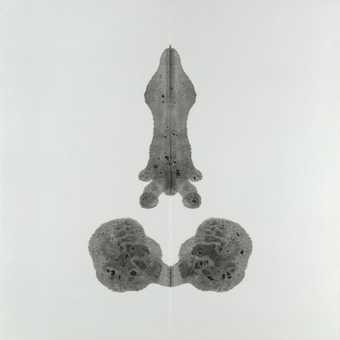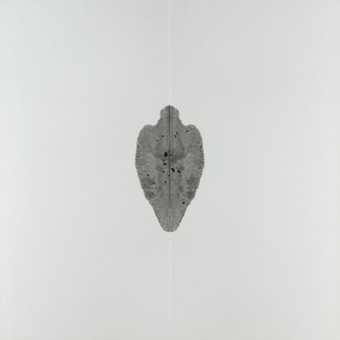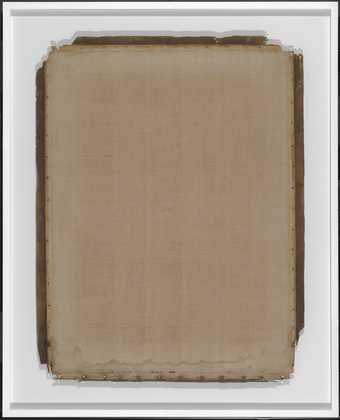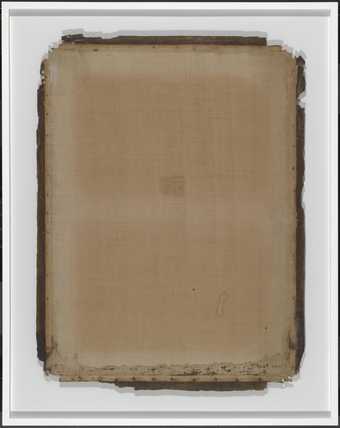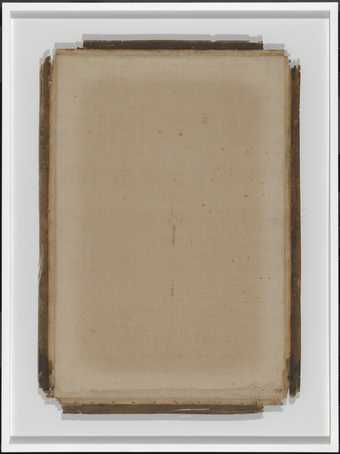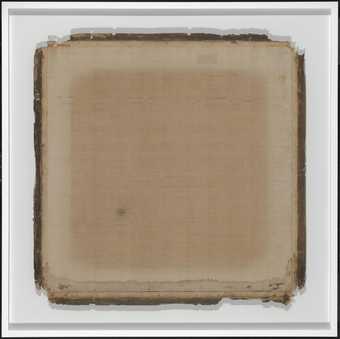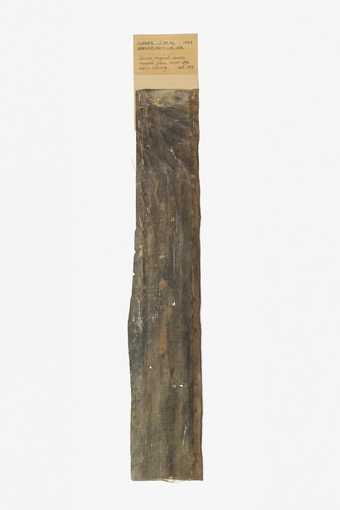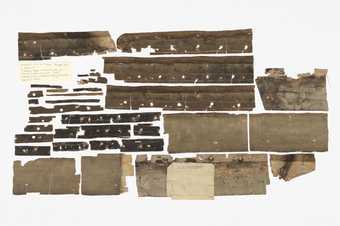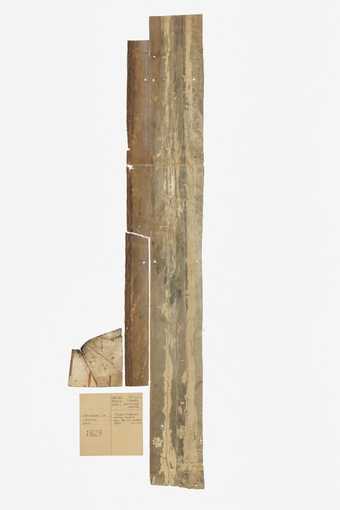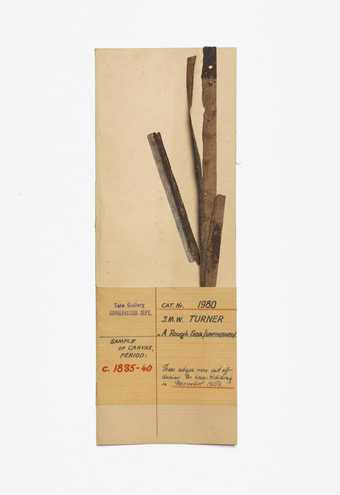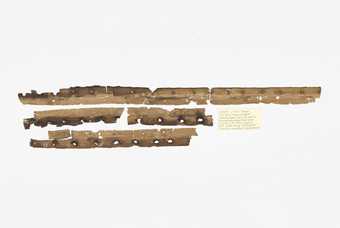Not on display
- Artist
- Cornelia Parker CBE RA born 1956
- Medium
- Silver and copper wire
- Dimensions
- Collection
- Tate
- Acquisition
- Purchased with assistance from Maggi and David Gordon 1998
- Reference
- T07461
Summary
Thirty Pieces of Silver comprises over a thousand flattened silver objects, including plates, spoons, candlesticks, trophies, cigarette cases, teapots and trombones. All the objects were ceremoniously crushed by a steamroller at Cornelia Parker’s request. She then arranged the transformed silver artefacts into thirty disc-shaped groups, which are suspended about a foot from the floor by hundreds of fine wires. Each ‘disc’ is approximately ninety centimetres in diameter and they are always hung in orderly rows, although their overall configuration is adapted each time to the space in which the work is displayed. The title refers to the biblical story of how the apostle Judas Iscariot betrayed Jesus in return for thirty pieces of silver. When the work was exhibited in the Hayward Gallery’s British Art Show of 1990, Parker commented on the work in the exhibition catalogue:
Silver is commemorative, the objects are landmarks in people’s lives. I wanted to change their meaning, their visibility, their worth, that is why I flattened them, consigning them all to the same fate. As a child I used to crush coins on a railway track – you couldn’t spend the money afterwards but you kept the metal slivers for their own sake, as an imaginative currency and as physical proof of the destructive powers of the world. I find the pieces of silver have much more potential when their meaning as everyday objects has been eroded. ‘Thirty Pieces of Silver’ is about materiality and then about anti-matter. In the gallery the ruined objects are ghostly levitating just above the floor, waiting to be reassessed in the light of their transformation. The title, because of its biblical references, alludes to money, to betrayal, to death and resurrection: more simply it is a literal description of the piece.
(Quoted in British Art Show, exhibition catalogue, Hayward Gallery, London 1990, p.88.)
Parker’s work frequently transforms the nature of an object or material through the use of extreme force. She has crushed, stretched and exploded numerous objects, while also enlisting the help of such unlikely collaborators as the British Army, the Colt Firearms Factory in Connecticut and H.M. Customs and Excise. Cold Dark Matter: An Exploded View 1991 (Tate T06949) is a pivotal piece in Parker’s career and exemplifies her often violent approach to materials. It comprises the charred remains of a garden shed that was blown up for the artist by the British Army. The residual fragments are suspended around a single light bulb. Thirty Pieces of Silver was the first large-scale work that featured what Parker calls a ‘cartoon death’. She has long been fascinated by the violence of cartoons: ‘flattening Tom, Jerry filled with bullet holes, Road Runner falling off a cliff. The deaths are only token ones as the characters always pop up again in the next frame.’ (Quoted in Virginia Button, ‘Conversation with Cornelia Parker’, Ninety, No.27, 1998, p.68.) Similarly, Parker is not interested simply in the destruction of materials, but more their resurrection and transformation.
Parker has since made many other works involving silver. For example, to make Measuring Niagara with a Teaspoon 1997 (Tate T07430), she took a Georgian teaspoon and had it melted down and then drawn into a wire whose length was equal to the height of the Niagara Falls. The value and meaning of silver, as well as its physical properties, have been a source of continual fascination for her. She has said that this is ‘because it is the most reflective metal that exists and [it] also has the ability to be the opposite very dull and black, it has the plus and minus in one material. Also linguistically in terms of the use of silver in language, ‘silver tongued’, silver lining’. It has a very poetic aura around it, it’s used in mirrors in which we see ourselves and in telescopes to look at the universe ... It’s part of our cultural make-up somehow, it has all kinds of ways of being in the world. Metals, in general, I love but I think that silver is my favourite’. (Quoted in unpublished excerpt of interview with Tate curator Virginia Button, 1998.)
Cornelia Parker, exhibition pamphlet, Serpentine Gallery, London 1998.
Cornelia Parker, exhibition catalogue, Institute of Contemporary Art, Boston 2000, reproduced p.42.
Cornelia Parker, exhibition catalogue, Galleria Civica d’Arte Moderna e Contemporanea, Turin 2001, reproduced in colour, p.92.
March 2003
Does this text contain inaccurate information or language that you feel we should improve or change? We would like to hear from you.
Technique and condition
The sculpture consists of 1116 silver-plated objects, including cutlery, dishes, candle holders, musical instruments, presentation cups and light fittings. The artist arranged to have these objects steamed rolled to flatten them. When displayed, the objects are arranged in pools containing between thirty-three and forty-six pieces. The configuration of these pools is variable. The objects have been drilled in two or three places so that they can each be suspended from a mesh ceiling using tinned copper wire. The length of the wire is also variable depending on the ceiling height but the pools are suspended 5’’ (102mm) above the ground.
There is no applied finish but the objects have been polished. Some objects have been rendered fragile by the steam rolling. The silver plating is worn on various objects and in some cases the alloy is visible. The objects are polished before each display as instructed by the artist.
Bryony Bery
April 2004
Explore
- emotions, concepts and ideas(16,416)
-
- emotions and human qualities(5,345)
-
- memory(367)
- formal qualities(12,454)
-
- defacement(257)
- distortion(58)
- fragility(50)
- repetition(391)
- suspension(41)
- universal concepts(6,387)
-
- destruction(383)
- ephemerality(51)
- transformation(186)
- instrument, trombone(57)
- silverware(4)
- candlestick(53)
- fork(28)
- knife(45)
- serving dish(17)
- spoon(25)
- tea pot(33)
You might like
-
Cornelia Parker CBE RA Cold Dark Matter: An Exploded View
1991 -
Cornelia Parker CBE RA Pornographic Drawing
1996 -
Cornelia Parker CBE RA Pornographic Drawing
1996 -
Cornelia Parker CBE RA Pornographic Drawing
1996 -
Cornelia Parker CBE RA Measuring Niagara with a Teaspoon
1997 -
Cornelia Parker CBE RA From ‘Mountain Scene with Lake and Hut’ circa 1840-5, JMW Turner, N05476, Tate Collection
1998 -
Cornelia Parker CBE RA From ‘Mountain Landscape’ circa 1840-5, JMW Turner, N05486, Tate Collection
1998 -
Cornelia Parker CBE RA From ‘Scene in Venice’ circa 1840-5, JMW Turner, N05488, Tate Collection
1998 -
Cornelia Parker CBE RA From ‘Seascape with Distant Coast’ circa 1840, JMW Turner, N05516, Tate Collection
1998 -
Cornelia Parker CBE RA From ‘A River Seen from a Hill’ circa 1840, JMW Turner, N05475, Tate Collection
1998 -
Cornelia Parker CBE RA From ‘Margate’ exhibited 1808, JMW Turner, N03876, Tate Collection
1998 -
Cornelia Parker CBE RA From ‘Rough Sea’ circa 1840-5, JMW Turner, N05479, Tate Collection
1998 -
Cornelia Parker CBE RA From ‘Chichester Canal’ circa 1828, JMW Turner, N00560, Tate Collection
1998 -
Cornelia Parker CBE RA From ‘Rough Sea with Wreckage’ circa 1830-5, JMW Turner, N01980, Tate Collection
1998 -
Cornelia Parker CBE RA From ‘The Tenth Plague of Egypt’ exhibited 1802, JMW Turner, N00470, Tate Collection
1998



